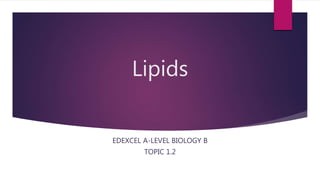
Lipids - Edexcel A-Level Biology B Topic 1.2
- 1. Lipids EDEXCEL A-LEVEL BIOLOGY B TOPIC 1.2
- 2. Facts A group of organic molecules Have a vital role within organisms Form an integral part of all cell membrane Also used as an energy store Many plants and animals contain lipids to provide energy for the seedling when it starts to grow, this is why seeds are important food source for many animals
- 3. Fats and Oils Important group of lipids Chemically similar, however fats (e.g. butter) are solid at room temperature, whereas oils (e.g. olive oil) are liquid at room temperature All contain carbon, oxygen and hydrogen atoms Contains a lower proportion of oxygen than carbohydrates Made up of fatty acids and glycerol (propane-1,2,,3- triol) Combined using ester bonds Glycerol's chemical formula is C3H8O3
- 4. Fats and Oils Structure All have a long hydrocarbon chain Pleated backbone of carbon atoms and hydrogen atoms attached Have a carboxyl group of –COOH at one end Living tissues have 70+ different kinds of fatty acids they vary in 2 ways 1. Length of the chain can differ 2. Fatty acid can be saturated or unsaturated
- 5. Saturated Vs Unsaturated Saturated Carbon atoms joined together by a single covalent bond e.g. stearic acid, found in both plant and animal fats Unsaturated Carbon chains have 1 or more double covalent bonds Monounsaturated fatty acid = 1 double bond Polyunsaturated fatty acids more than 1 double bond e.g. linoleic acid, is essential in our diet as we cannot make it from other chemicals
- 6. Forming Ester Bonds Fat or oil is produced, when glycerol combines with 1, 2 or 3 fatty acids to form a monoglyceride, a diglyceride or a triglyceride During a condensation reaction a bond is formed between the carboxyl group (-COOH) of a fatty acid, and one of the hydroxyl groups of (-OH) of glycerol. A molecule of water is removed and the resulting bond in known as an ester bond. This type of condensation reaction is called Esterification The nature of the lipid formed depends on which fatty acids are present. Lipids containing saturated fatty acids are more likely to be solid at room temperature than those containing unsaturated fatty acids
- 7. The Nature of Lipids Contain many carbon-hydrogen bonds and little oxygen When lipids are oxidised during respiration, bonds are broken and the products are carbon dioxide and water. This reaction can be can be used to drive the production of a lot of ATP Lipids (especially triglyceride) stores 3x as much energy as the same mass of carbohydrates Lipids are hydrophilic – waterproofing organisms, oils are important in waterproofing the fur and feathers of mammals and birds. Insects and plants use waxes for waterproofing their outer surfaces Good insulators, a fatty sheath insulates your nerves so the electrical travel faster Insulate animals against heat loss e.g. whales have a thick layer of blubber Very low density – body fat of water mammals helps them to float easily All dissolve in organic solvents, but are insoluble in water, so don’t interfere with the many water based reactions that go on in the cytoplasm of a cell
- 8. Phospholipids Inorganic phosphate ions ( -PO4^3-) are present in the cytoplasm of every cell Sometimes 1 of the hydroxyl groups of glycerol undergoes esterification with a phosphate group instead of a fatty acid, & a simple phospholipid is formed Phospholipids are important because the lipid and the phosphate parts of the molecule give it very different properties Phospholipids 1. Fatty acid chains are neutral and insoluble in water 2. Phosphate head (- negative charge), soluble in water 3. When in contact in water the 2 parts of the molecule behave differently 4. Polar phosphate = hydrophilic, dissolves readily in water 5. Lipid tails = hydrophobic, don’t dissolve in water 6. If they are tightly packed in water they form a monolayer, (heads in water, tails in air), or clusters called micelles 7. Micelle = all hydrophilic heads point outwards and all hydrophobic tails are inside
- 9. Phospholipid Diagrams Phospholipid Monolayer Micelle
- 10. Phospholipids Rarely, a phospholipid monolayer may form, at a surface between air and water in living cells where there are water based solution on either side of the membranes. With water on each side the phospholipid molecules form a bilayer with the hydrophilic heads pointing into the water, protecting the hydrophobic tails in the tails in the middle. This structure, the unit membrane, is the basis of all membranes.